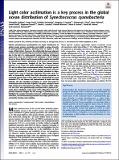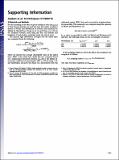Por favor, use este identificador para citar o enlazar a este item:
http://hdl.handle.net/10261/164360COMPARTIR / EXPORTAR:
 SHARE SHARE
 CORE
BASE CORE
BASE
|
|
| Visualizar otros formatos: MARC | Dublin Core | RDF | ORE | MODS | METS | DIDL | DATACITE | |

| Título: | Light color acclimation is a key process in the global ocean distribution of Synechococcus cyanobacteria |
Autor: | Grébert, Théophile; Acinas, Silvia G. CSIC ORCID ; Garczarek, Laurence | Palabras clave: | Tara Oceans Phycobilisome Light quality Metagenomics Marine cyanobacteria |
Fecha de publicación: | feb-2018 | Editor: | National Academy of Sciences (U.S.) | Citación: | Proceedings of the National Academy of Sciences 115(9): E2010-E2019 (2018) | Resumen: | Marine Synechococcus cyanobacteria are major contributors to global oceanic primary production and exhibit a unique diversity of photosynthetic pigments, allowing them to exploit a wide range of light niches. However, the relationship between pigment content and niche partitioning has remained largely undetermined due to the lack of a single-genetic marker resolving all pigment types (PTs). Here, we developed and employed a robust method based on three distinct marker genes (cpcBA, mpeBA, and mpeW) to estimate the relative abundance of all known Synechococcus PTs from metagenomes. Analysis of the Tara Oceans dataset allowed us to reveal the global distribution of Synechococcus PTs and to define their environmental niches. Green-light specialists (PT 3a) dominated in warm, green equatorial waters, whereas blue-light specialists (PT 3c) were particularly abundant in oligotrophic areas. Type IV chromatic acclimaters (CA4-A/B), which are able to dynamically modify their light absorption properties to maximally absorb green or blue light, were unexpectedly the most abundant PT in our dataset and predominated at depth and high latitudes. We also identified populations in which CA4 might be nonfunctional due to the lack of specific CA4 genes, notably in warm high-nutrient low-chlorophyll areas. Major ecotypes within clades I–IV and CRD1 were preferentially associated with a particular PT, while others exhibited a wide range of PTs. Altogether, this study provides important insights into the ecology of Synechococcus and highlights the complex interactions between vertical phylogeny, pigmentation, and environmental parameters that shape Synechococcus community structure and evolution | Descripción: | Grébert, Théophile ... et al.-- This article is contribution number 69 of Tara Oceans.-- 10 pages, 4 figures, supporting information http://www.pnas.org/content/suppl/2018/02/09/1717069115.DCSupplemental | Versión del editor: | https://doi.org/10.1073/pnas.1717069115 | URI: | http://hdl.handle.net/10261/164360 | DOI: | 10.1073/pnas.1717069115 | Identificadores: | doi: 10.1073/pnas.1717069115 issn: 0027-8424 e-issn: 1091-6490 |
| Aparece en las colecciones: | (ICM) Artículos |
Ficheros en este ítem:
| Fichero | Descripción | Tamaño | Formato | |
|---|---|---|---|---|
| Grebert_et_al_2018.pdf | 3,62 MB | Adobe PDF |  Visualizar/Abrir | |
| Grebert_et_al_2018_suppl_1.xlsx | 110,5 kB | Microsoft Excel XML | Visualizar/Abrir | |
| Grebert_et_al_2018_suppl_2.pdf | 8,55 MB | Adobe PDF |  Visualizar/Abrir |
CORE Recommender
PubMed Central
Citations
32
checked on 07-abr-2024
SCOPUSTM
Citations
77
checked on 11-abr-2024
WEB OF SCIENCETM
Citations
67
checked on 27-feb-2024
Page view(s)
237
checked on 18-abr-2024
Download(s)
316
checked on 18-abr-2024
Google ScholarTM
Check
Altmetric
Altmetric
Artículos relacionados:
NOTA: Los ítems de Digital.CSIC están protegidos por copyright, con todos los derechos reservados, a menos que se indique lo contrario.
